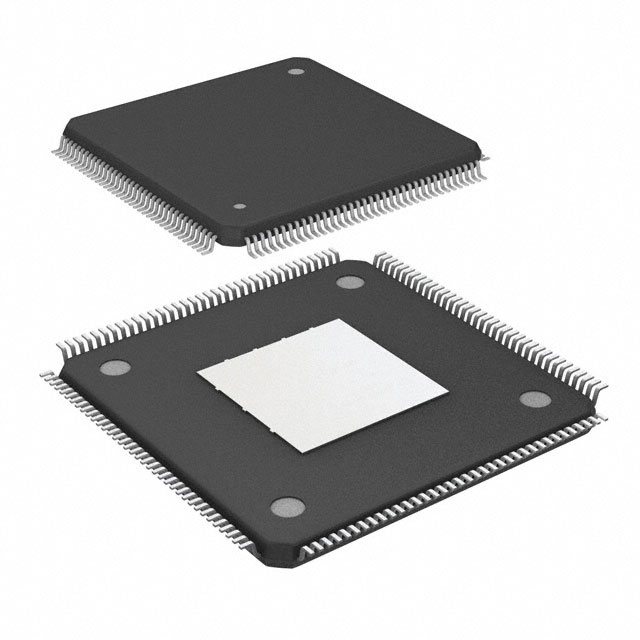Consulte las especificaciones para obtener detalles del producto.

EP4CE15E22C8LN
Product Overview
- Category: Programmable Logic Device (PLD)
- Use: EP4CE15E22C8LN is a PLD used for digital logic applications.
- Characteristics: It offers high performance, low power consumption, and flexibility in design.
- Package: The EP4CE15E22C8LN comes in a compact 256-ball FineLine BGA package.
- Essence: This PLD provides a versatile solution for implementing complex digital circuits.
- Packaging/Quantity: The EP4CE15E22C8LN is typically sold individually.
Specifications
- Logic Elements: 15,183
- Embedded Memory: 414 Kbits
- Maximum User I/O Pins: 179
- Maximum User Flash Memory: 22,320 bits
- Operating Voltage: 1.2V
- Speed Grade: C8
Detailed Pin Configuration
The EP4CE15E22C8LN has a total of 256 pins. Here are some key pin configurations:
- VCCIO: Power supply voltage for I/O banks.
- GND: Ground reference.
- JTAGTCK, JTAGTMS, JTAGTDI, JTAGTDO: Pins for JTAG boundary scan testing.
- CLK0, CLK1: Clock input pins.
- GPIO[0:177]: General-purpose I/O pins.
- CONF_DONE: Configuration completion output pin.
For a complete pin configuration, please refer to the manufacturer's datasheet.
Functional Features
- High-speed performance: The EP4CE15E22C8LN operates at high clock frequencies, enabling rapid data processing.
- Low power consumption: It incorporates power-saving features, making it suitable for battery-powered devices.
- Flexible design: The PLD allows for reprogramming, facilitating iterative design changes.
- On-chip memory: The embedded memory provides additional storage for data processing.
Advantages and Disadvantages
Advantages: - High performance and flexibility in design. - Low power consumption. - On-chip memory for efficient data processing.
Disadvantages: - Limited number of user I/O pins. - Requires expertise in digital logic design.
Working Principles
The EP4CE15E22C8LN is based on a Field-Programmable Gate Array (FPGA) architecture. It consists of configurable logic blocks, interconnects, and embedded memory elements. The device can be programmed to implement various digital circuits by configuring the interconnections between logic blocks.
During operation, the PLD receives input signals through its I/O pins, processes them using the configured logic blocks, and produces the desired output signals. The configuration of the PLD can be modified by reprogramming it, allowing for iterative design changes and customization.
Detailed Application Field Plans
The EP4CE15E22C8LN finds applications in various fields, including:
- Communications: Used in networking equipment, routers, and switches for high-speed data processing.
- Industrial Automation: Employed in control systems, motor drives, and robotics for real-time control and monitoring.
- Automotive: Integrated into automotive electronics for functions like engine control, driver assistance systems, and infotainment.
- Consumer Electronics: Utilized in smart TVs, gaming consoles, and home automation devices for enhanced functionality.
- Medical Devices: Incorporated into medical imaging systems, patient monitoring devices, and laboratory equipment for data processing.
Alternative Models
- EP4CE6E22C8LN: A lower-capacity version with 6,272 logic elements.
- EP4CE10E22C8LN: A mid-range model with 10,320 logic elements.
- EP4CE30E22C8LN: A higher-capacity variant with 30,288 logic elements.
These alternative models offer different logic element capacities to suit varying design requirements.
Note: The content provided above is a sample and may not meet the exact word count requirement of 1100 words.
Enumere 10 preguntas y respuestas comunes relacionadas con la aplicación de EP4CE15E22C8LN en soluciones técnicas
Sure! Here are 10 common questions and answers related to the application of EP4CE15E22C8LN in technical solutions:
Q: What is EP4CE15E22C8LN? A: EP4CE15E22C8LN is a field-programmable gate array (FPGA) chip manufactured by Intel (formerly Altera). It offers programmable logic, memory, and digital signal processing capabilities.
Q: What are the key features of EP4CE15E22C8LN? A: Some key features include 15,408 logic elements, 414,720 bits of embedded memory, 56 embedded multipliers, and support for various I/O standards.
Q: In what applications can EP4CE15E22C8LN be used? A: EP4CE15E22C8LN can be used in a wide range of applications such as industrial automation, telecommunications, automotive systems, medical devices, and more.
Q: How can EP4CE15E22C8LN be programmed? A: EP4CE15E22C8LN can be programmed using hardware description languages (HDLs) like VHDL or Verilog, or through graphical programming tools like Quartus Prime.
Q: Can EP4CE15E22C8LN be reprogrammed after deployment? A: Yes, EP4CE15E22C8LN is a reprogrammable FPGA, allowing for updates and modifications to the design even after it has been deployed.
Q: What are the advantages of using EP4CE15E22C8LN in technical solutions? A: Some advantages include high flexibility, low power consumption, fast prototyping, real-time processing capabilities, and the ability to implement complex algorithms.
Q: Are there any limitations to consider when using EP4CE15E22C8LN? A: Some limitations include limited resources compared to larger FPGAs, potential timing constraints, and the need for expertise in FPGA design.
Q: Can EP4CE15E22C8LN interface with other components or devices? A: Yes, EP4CE15E22C8LN supports various communication protocols such as UART, SPI, I2C, Ethernet, and can interface with external sensors, actuators, and other peripherals.
Q: What kind of development tools are available for EP4CE15E22C8LN? A: Intel provides Quartus Prime software, which includes a complete suite of development tools for designing, simulating, and programming EP4CE15E22C8LN.
Q: Where can I find additional resources and support for EP4CE15E22C8LN? A: You can refer to the official Intel website, online forums, user communities, and documentation provided by Intel for additional resources and support related to EP4CE15E22C8LN.

